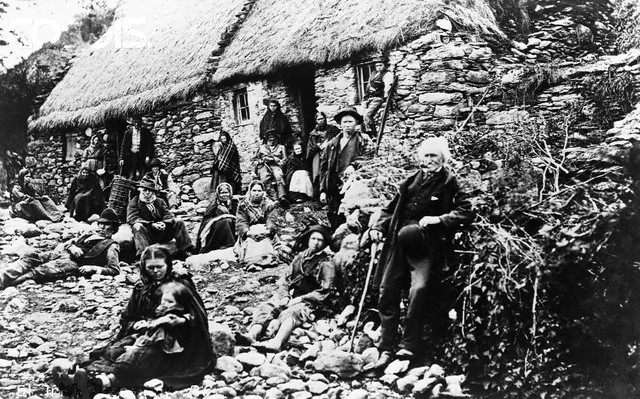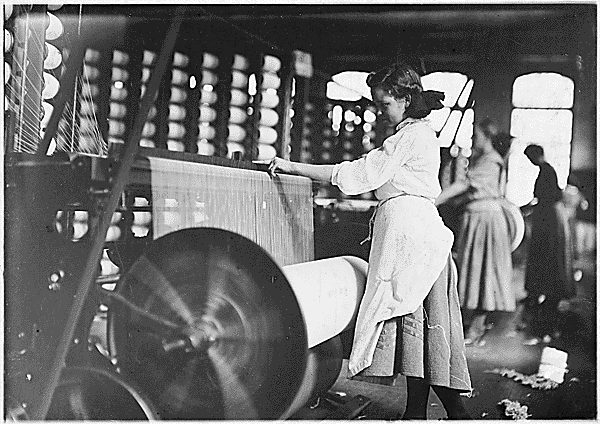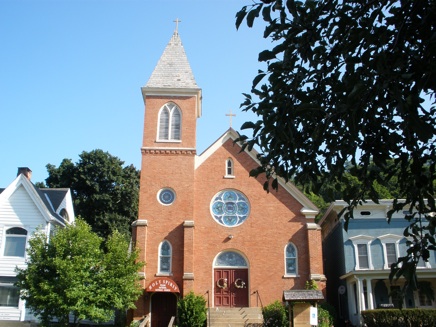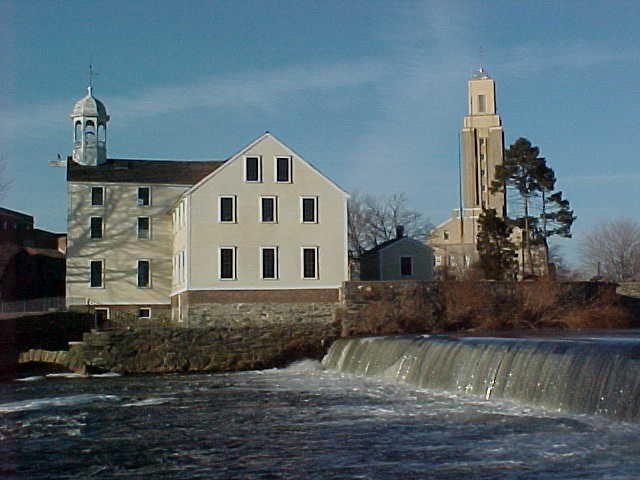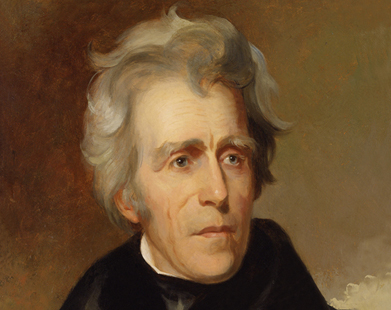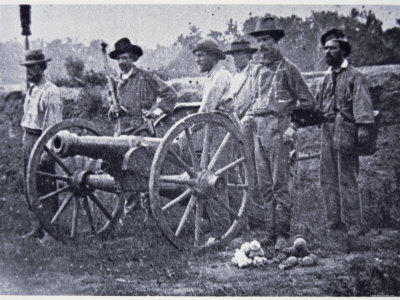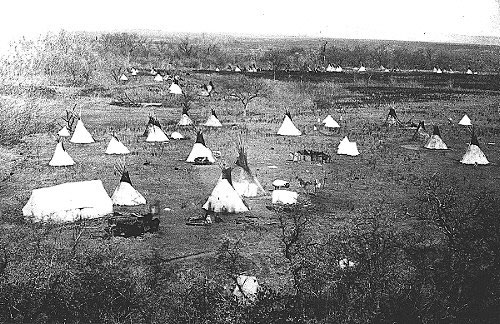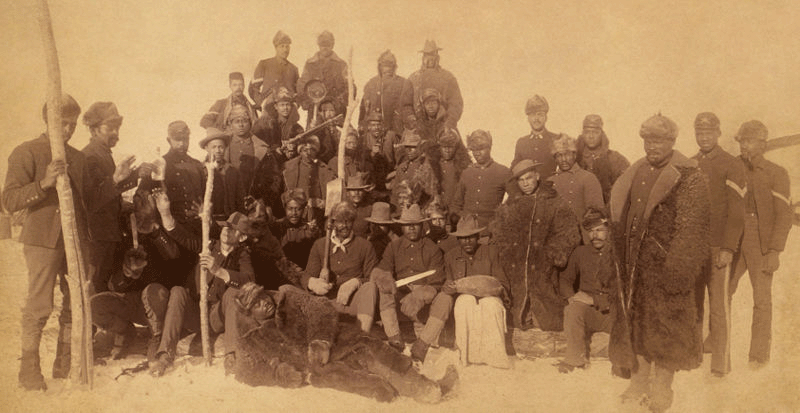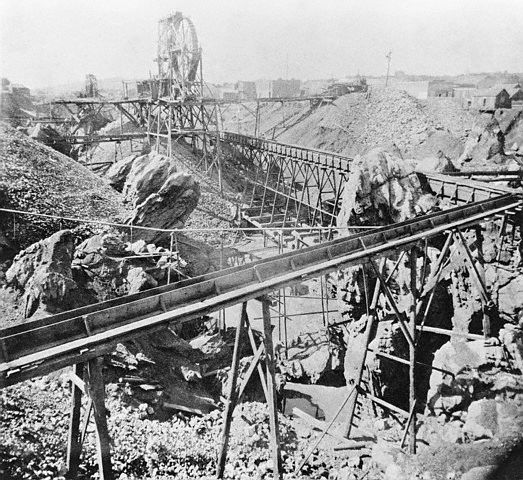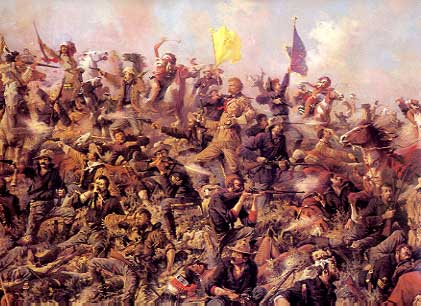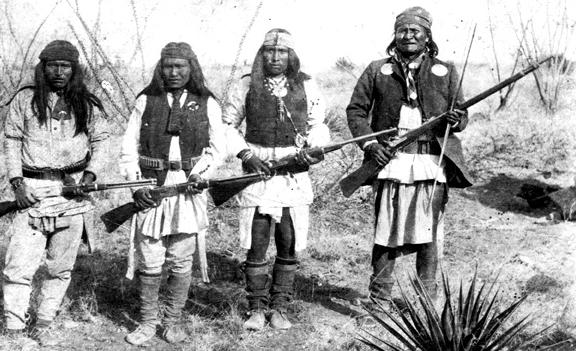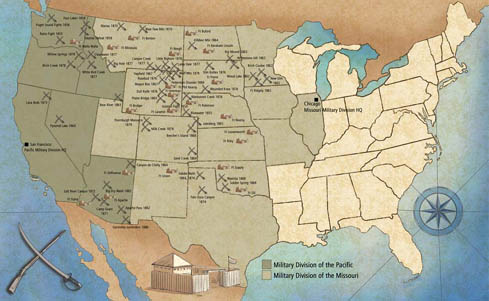Wednesday, March 30, 2011
Weekly Assignment 11
Read the 1892 People's (Populist) Party Platform (one pages 138-139 in the documents reader, or at the provided link), and then answer the following questions: What are the key planks of the People's Party platform? Which of these planks depart most from the major party positions (Republican Party and Democratic Party) of the time?
Emergence of Class Politics--Populism and Progressivism
I. The Farm Crisis – long term decline in commodity prices coupled with tight credit situation meant increasingly difficult times for farmers, particularly in the South and in the Great Plains areas—areas which saw the greatest successes of the Grange, the Farmers’ Alliance, and the People’s party.
A) Economic conditions
1) Decline in commodity prices – from 1870 to 1898, commodity prices on foodstuffs declined, which meant the farmers received less return on the investment they made
2) Dependency on railroads and banks – the economic power of all large corporations frightened many Americans, but particularly the power of railroads and banks. Farmers were entirely reliant upon railroads to get their product to the market, and to receive those items from the market that they wished to buy. Banks controlled credit, and their refusal to make loans to farmers by taking land as collateral meant that many farmers had great difficulty obtaining new machinery and making other capital investments that they felt they needed.
3) Tariff policy – the high tariffs protected US manufacturers from foreign competition, but it also made for higher prices for most consumer goods, which meant that farmers and workers had to spend more of their income for the necessities of life.
B) The Farmers’ Responses
1) Granger Movement – began in 1867 when Oliver H. Kelley wanted to develop a means for Southern farmers to overcome their isolation. Because isolation was a common condition for many farmers, this movement became very popular. Quickly developed into a way for farmers to develop cooperative ventures for the buying and selling of goods, to free farmers from the conventional marketplace. The Granger movement gradually declined (although it never completely vanished) as more and more members were drawn into political movements. The Grange also tended to draw as members the more prosperous farmer.
2) Greenback-Labor Party – advocated the continued use of paper money—known as “greenback”—instead of a return to the gold or silver standard. This inflationary money policy was felt by many farmers to be the root cause of much of their hardships. Greenbackers made alliances with workers organizations because both parties were concerned about the growing influence of monied corporate interests were gaining in the hall of government.
3) Farmers’ Alliance – most popular in the South and the Great Plains are; attracted many poorer farmers than were attracted to the Grange. Although there were not bi-racial local organizations, nor were the national organizations bi-racial, there was limited bi-racial cooperation between white and African American groups in the South—because the Colored Farmers Alliance agreed to limit itself to demands for economic equality, not social equality.
(a) Provided members with sense of community, which attracted a great number of farmers who felt isolated.
(b) Provided farmwomen with a greater sense of purpose, that their lives could encompass more than “Drudgery, fashion, and gossip were no longer the bounds of woman’s sphere.”
(c) Grass roots movement – Alliance cells fostered the development of local leaders; a number of charismatic speakers like Mary Elizabeth Lease (quoted as saying the farmers “should raise less corn and more hell”) and “Sockless” Jerry Simpson.
(d) Use of vigilante justice – farmers often worked in concert against thieves and greedy ranchers, who tried to enclose common grazing areas.
(e) Promotion of racial understanding – in the South, although separate Alliances were maintained for blacks and whites, recognition was beginning to dawn on a number of members that white and black farmers had many things in common; in the words of Southern Alliance leader Tom Watson, “You are kept apart that you may be fleeced of your earnings.”
C) Farmers’ Alliance Proposals
1) Alliance Exchange – proposal by Charles W. Macune to allow Alliance members to sign joint bank notes for loans, and to set up a corporation owned by the Alliance were farmers could buy needed supplies. Plan had to be abandoned when Texas bankers refused to allow farmers to sign joint notes.
2) Subtreasury Plan – proposal by Alliance president Charles W. Macune to allow farmers to store their grain in government owned silos until a higher price was asked for the grain, when the farmer could then sell it at this more favorable higher price; would also allow farmers to obtain low-interest loans up to the value of 80% of his crop. Banks refused to go along with this idea; it was introduced as a bill in Congress, but it was allowed to die in committee
3) Proposals to ease credit restrictions – attempts to pressure bankers to ease credit restrictions
D) The Shift to Politics
1) The People’s Party – many Alliance members developed the idea that they would only see the proposals that they put forth become reality if they were able to exert some political pressure. The People’s Party, or Populists, were more successful in the West (particularly Kansas, Nebraska, and the Dakotas) than in the South, where white voters were extremely resistant to abandoning the Democratic Party
(a) Election of 1892 -- People’s Party run candidates for President (James B. Weaver) and vice-president on a platform backing the subtreasury plan, free and unlimited coinage of silver, a pledge to increase the amount of money in circulation, and institute a graduated income tax. Although Weaver stirs few with the power of his oratory, his candidacy does draw over a million votes—and, more importantly, he carried the states of Colorado, Kansas, Nevada, and Idaho, for a total of twenty-two electoral college votes, enough to give Cleveland the victory over Harrison.
II) The System of 1896 – the response on the part of the two major political parties charted the course for American politics until the onset of the Great Depression and the election of 1932.
A) Depression of 1893 – the most severe economic depression that the United States had faced to that point, set off by the bankruptcy of the Philadelphia and Reading Railroad, which then set off a panic on Wall Street when British investors began pulling financial backing out of American firms and demanding gold payment. Over 750,000 workers eventually went out on strike that year, and millions found themselves suddenly unemployed. Caused in part by a lack of currency in circulation, by the fact that currency growth had not kept pace with the growth of the economy.
1) Silverites and Goldbugs – when the majority of currency in circulation was made of precious metals, the worth of the metal in the coin would supercede its worth as currency, and therefore people would not spend it (especially true for gold).
(a) “Free and unlimited coinage” – people would present their gold or silver to the government, which would make coins of it; once gold or silver was turned into a coin, it was no longer able to fluctuate with the value of the precious metal that it contained.
2) 1894 Election – not surprisingly, many people blamed the party that controlled the White House for this fiasco, and returned majorities for the Republican Party in both the House and the Senate.
B) William Jennings Bryan – the “Boy Orator of the Plains.” Bryan seized upon the silver issue, and made it his own. Bryan was also the first politician from a major party to identify with the (white) underclass, mainly the small farmer, because his devotion to the tenets of his Baptist creed largely prevented immigrant workers in cities from identifying with him or his cause (a fact that proved fatal in the fall election that year).
1) “Cross of Gold” speech – speech before the Democratic convention in 1896 brought many in the audience to tears with its eloquence; however, it did not persuade all of the members of the party to back his candidacy after Bryan won the nomination—the goldbug faction of the party walked out of the convention and named their own candidate, Alton Parker, who promptly proclaimed that he saw no reason for a gold Democrat not to vote for the Republican candidate, William McKinley.
2) Split of Democratic Party – essentially remains unhealed until the rise of FDR in 1932, when he is able to patch together a coalition of urban ethnic workers, blacks, and Southern plutocrats.
C) Marcus J. Hanna – Cleveland oil man, associate of John D. Rockefeller, in politics to further his economic ends and those of his friends. Although he was only the campaign manager for McKinley in this election, he is by far the more important figure.
1) The Businessman’s Tax – because of the enmity that Bryan stirred in the business class, with his appeals to small farmers, workers, and the downtrodden, Hanna was able to essentially “tax” a number of businessmen in the country, to the tune of somewhere between $3.5 and $7 million (compared to Bryan’s war chest of $300,000), which allowed the McKinley campaign to outspend Bryan by a 15 to 1 margin.
2) “Economic Chaos” – businessmen promise they will close down their factories if Bryan were elected; this dissuades many workers who may have been inclined to overlook Bryan’s fundamentalist side to vote for McKinley instead.
D) The Forces of “Good Government” – as a result of the forces unleashed in the period after the Civil War, which seemed to be coming to a head at the end of the 1890s, dramatic changes in the way local governments are constituted quickly evolve.
1) Attempts to remove politics from local government.
(a) Development of City Manager style government – the cities of the South first develop this; suppose to put the reigns of power in a city in the hands of an “expert” and remove the hazards of politics from government. In effect, this removes the governing of the city from its citizens, who have no direct say in who is responsible for the day-to-day running of the city.
(b) At-Large Elections – again removes responsibility from those elected, which is no longer answerable to any one constituency—except that constituency which can afford to provide campaign funds.
III) Conclusion – the growth of the Progressive Movement is spurred by the “dangers” that the conflict between capitalists and labor seems to hold for the ability of the upper middle class to retain control of the body politic; most of the people who become associated with the Progressive Movement are in fact working to regain that control.
Monday, March 28, 2011
Immigration in the United States
I) Old immigration – historians in the past have used the designations “old immigration” and “new immigration” to distinguish between those people who came from northern and western Europe (the old immigrants) and southern and eastern Europe (the new immigrants). I purpose to use these old terms in new ways: to designate the old immigration as those immigrants who came before 1870; and those who came after. Technological innovations in travel, both sea and land, make this distinction viable because then we can highlight the real difference between immigrants, those who came to establish new homes, and those who came to earn enough money to improve their old homes.
A) Irish as old immigrants – the Irish were a highly visible old immigration group, because they tended to be mainly Roman Catholic (and perceived as a threat to the freedoms of a profoundly Protestant—if avowedly secular—country), and because they immigrated in huge numbers.
1) Changes in landholding – although we traditionally think of the number one cause for Irish immigration as the Great Famine, Black ’47, Irish immigration in large numbers actually began years before the Famine. In fact, changes in landholding patterns throughout Europe were the primary cause for the immigration of peasants to the western hemisphere.
(a) Termination of serfdom – serfdom (a classification of station, of social order, similar to slavery) existed throughout Europe at the beginning of the modern era (for our purposes, 1600). Serfs were peasants who were tied to the land they worked for their lord (the owner of a manor). Serfs usually owed their lord a portion of the crop that they raised, and usually had to perform a fixed amount of labor for the lord on the manor, as well. Serfs were not completely propertyless, however; they usually owned a crude house, the adjoining land, and a small portion of plot that was worked in common. Serfdom was ended in England and the British Isles (including at this stage Ireland), in the 1600s; there were few serfs in France by the French Revolution in 1789. Serfdom did not completely disappear in Europe at this earlier time period, however; it existed in Prussian well into the 1800s, and Russian did not abolish serfdom until 1861. The termination of serfdom meant, however, that a large portion of the population in Europe was now free to roam around, and many peasants did so, seeking employment to supplement their subsistence from the land.
(b) Termination of the commons – a portion of a manor was common land, or the commons—land which all members of the community had rights to use. Use of the commons continued to exists in western Europe after serfdom ended, which allowed the practice of subdividing land among all of the male heirs in a family, since they could use the commons to hunt, gather peat for fires (there were very few trees left in Europe, particularly in England and Ireland, by this time, and most of the trees that were left the monarch claimed for military use), and graze livestock. With the growing importance of raising commercial livestock, the former lords of the manor (who remained the largest landholders), began seizing the commons; to keep the livestock of villagers from using the former commons area, large hedges were grown around the perimeter to keep other livestock out. These hedges can still be seen in England and Ireland, even though free range (similar to the commons idea) has returned in Ireland.
(c) Rise of primogeniture landholding – the amount of land to be divided became smaller, because of the practice of division among all male family members, and because much of the land was held be gentry class. This meant that individual landholdings got smaller, and had to be farmed more intensively—which became disastrous when the famine hit Europe.
2) Rise of manufacturing – as landholding was changing in Europe (particularly in England and Ireland), manufacturing and industrialization were beginning to take off in England and the United States.
(a) Manufacturing in England – the manufacturing of textiles in England—particularly in Liverpool and Manchester—as well as the manufacturing of iron and steel in Birmingham attracted workers from around the British Isles, who searched for ways to increase their incomes. Many agricultural workers and displaced farmers began to migrate to these developing industrial areas during lulls in the agricultural year to supplement their incomes; some stayed on permanently.
(b) Manufacturing in the United States – opportunities in manufacturing in the United States—as well as jobs constructing a transportation infrastructure (canals and railroads) attracted a great number of these displaced peasants and agricultural workers, particularly during the 1820s and 1830s.
(i) Because of the increased cost of migrating to the United States (as opposed, say, to Liverpool or Birmingham) meant that only immigrants with some means came to the United States—that is, they had some prior savings, or some skill that they hoped would transfer (many Irish immigrants had been cottagers in Ireland—that is, they worked as independent textile manufacturers. Most had to leave their looms behind, and upon arrival in the States found that most textile manufacturing was done in factories, anyway)
3) Black ’47 – the potato blight affected much of Europe, and was part of the cause of the increased migration from Germany, as well as Ireland.
(a) Reliance on the potato – because of the small amount of arable land available to most European (and especially Irish) farmers, they sought a crop that provided the greatest amount of calories per acre, which happened to be potatoes.
(b) The potato blight – the first year of the blight was 1845, devastating much of the crop that year; 1846 the blight was less worse, and seemed less threatening; 1847 it devastated most of the potato crop, as well as much of the population.
(c) Blight and immigration – the blight increased the urgency of immigration from Ireland, which was already occurring.
(i) Immigration to England – the poorest immigrants immigrated across the Irish Sea to England; because of their dire condition, many did not complete even this short journey.
(ii) Immigration to the United States – many Irish immigrants to the United States, while they arrived in the country destitute and often in ill health, were those who began the journey with the best chance of survival. Even so, about 10% died on the journey, a rate roughly comparable to slave ships.
B) Transportation technology
1) Sailing ships – the trip across the Atlantic took anywhere from three to six weeks, depending upon the weather and the port of departure. This length of time, and the conditions of travel in steerage, where most immigrants spent the trip, contributed to the mortality rate. The change of technology to screw-driven, steam-powered ships in the 1870s and 1880s had the double effect of decreasing the length of time the journey took, as well as dropping the price of the trip
C) The “Immigration Problem”—the assimilation of immigrant groups has caused concern among political elites in the United States since before there was a United States; Benjamin Franklin was suspicious of the people he called the “Dutch” in the area around Philadelphia (largely because of their loyalty to the Penn family, with whom Franklin was in near constant dispute with) is one of the early examples.
1) Local politics—new immigrant groups were viewed by political and economic elites as compliant tools of corrupt, big-city political “machines.” Immigrants could only make demands on these machines when they had votes to trade for services, however.
2) Hull House—established by Jane Addams and Ellen Starr in Chicago in 1889, in one of the poorest immigrant neighborhoods in the nation. Before Hull House residents provided political organization (and lots of publicity), residents in the neighborhood received few city services.
II) New Immigration
A) Transportation technology -- the change in technology allowed peasants and workers to move back and forth between Europe and the United States, which both the eastern and southern European immigrant, as well as those from northern and western Europe, took advantage of.
1) Screw-propeller steamships – the invention of the screw-propeller steamship cut down the length of travel from three to six weeks to one to three weeks, again dependent upon the port of departure (and arrival). This increase in speed allowed ships to make more trips; this led to the development of ships devoted to carrying passengers (to this point, the main income for a ship was cargo, rather than passengers), which allowed better accommodations for steerage passengers as well as cutting the cost of the trip to less than $10 one way.
2) Sojourners/Remigrants – there had always been sojourners (people who intended only to be temporary residents of a country—also referred to as remigrants), but the price drop for the trip, and the growing assurance that one would survive the trip in relative comfort, made the trip to the United States increasingly attractive to large numbers of working-class Europeans.
(a) Signaled a change in the nature of US immigration, because many of the people entering the country after 1870 did not intend to become permanent residents of the country, let alone become citizens.
(i) Increased resentment and angry reaction on the part of native Americans, which contributed to the renewed nativist sentiment in the country (leading eventually to legislation being passed in 1924 to restrict the numbers of immigrants allowed in the country each year.
(b) Attracted by high wages in US – the wages that a sojourner could obtain in US industry outpaced by far the wage they could command for agricultural and industrial work in Europe, and resulted in huge numbers of these workers, largely male, making their way to the United States.
(i) The labor movement, which should have worked to organize these new immigrants to keep them from lowering the wage rates for all workers, instead attempted to restrict the number of immigrants allowed into the country each year
(ii) Chinese Exclusion Act (1882) – at the instigation of labor in the West, particularly in California, but the entire labor movement eventually fell in line on this matter, including the Knights of Labor, which had practiced bi-racial unionism.
(iii) Because of immigrant interest in earning as much money as quickly as possible, most were uninterested in striking, or joining unions which often demanded union dues.
(i) Few immigrants in the 1870-1920 time period came with skills, so were unattractive to unions within the AFL (the dominate organization for labor during this time period—although the founder of the AFL, Samuel Gompers, was himself a Jewish immigrant from England.
B) Immigrant institutions
1) Church – many immigrants came from countries were Roman Catholicism was the dominant religion; the Church in Europe was dominated generally by the ethnic group that dominated within the country; in the United States, the RC Church was dominated by Irish and German clergy.
(a) Polish National Catholic Church – the response of a small part of the Polish population in the US was to establish their own church, which retained the practices of the RC Church except for recognition of the ecclesiastical authority.
(b) Conversion to Protestant sects – some immigrants converted to a Protestant sect, which caused consternation when they returned home to establish new churches.
2) Fraternal organizations – because of the high-risk jobs that immigrants tended to take (in return for what they thought were high wages), insurance became increasingly important (for burial, etc.)
3) Saloons – one of the avenues for upward mobility for immigrants was to open a saloon. This became a social gathering place for members of ethnic groups, a place where they could read newspapers, carry on conversations in their native tongues, receive and send mail, and bank. The saloon also served as a center from which to gather information about job openings, because the saloon owner was usually well connected.
C) 20th Century changes in immigration
1) Democratization of Europe – with the defeat of the Axis Powers in World War I, most monarchies on the Continent were done away with, and ethnic groups found themselves able to create their own governments; this not only tended to keep peasants home, but also drew back (initially) migrants already in the United States.
(a) Poland – had been a part of three different countries since the late 1700s, and was able to establish its own government (until 1939, that is)
(b) Czechoslovakia
(c) Yugoslavia
(d) Austria
(e) Hungary
2) Immigration restrictions – by 1924, when the euphoria for the new governments was wearing off, restrictions on immigration in the US became law, and took effect by 1927.
3) Economic depression – by the beginning of the 1930s, the worldwide economic depression ended employment opportunities in the United States.
III)Conclusion
Wednesday, March 23, 2011
Triangle Shirtwaist Fire, March 25 1911--Extra Assignment
Watch the full episode. See more American Experience.
The Triangle Shirtwaist Fire is one of the most important--and tragic--events in American Labor History. In the late afternoon of March 25, 1911--just before quitting time that Saturday, in fact--a fire broke out on the 9th floor of the building housing the Triangle Shirtwaist Company. The Order Department, located on the 8th floor, immediately notified company management, located on the 10th floor, and persons on both of those floors escaped harm. But no one from the company thought to evacuate the workers located on the floor between, and as a result they were trapped. Some were able to escape to the roof of the building. Many more, fearing being burned to death in the fire, leaped to their death from the 9th and 10th floors of the building.
The factors that contributed to this tragedy were numerous--from New York Fire Department ladders that only reached to the 6th floor, to the cramped work quarters with wicker baskets full of scrap cloth and the oil impregnated floor in the factory. Many of the contributed factors may have been overcome, but a door the the stairway was locked (either to keep union organizers out, or to keep workers from leaving early); other doors that would have allowed the women to escape opened inward, and were blocked as the by now panicked women attempting to escape.
The fear of unionization was very much on the minds of the owners of the Triangle Shirtwaist Company. In 1910, the "Uprising of the 20,000" led to the unionization of many rival shirtwaist companies. Triangle was able to resist the unionization drive, and therefore also resist the demand of its workers to unlock the doors of the factory and to ensure that the fire escapes were functional. Those demands remained unaddressed on March 25, 1911.
This tragedy deeply touched many New Yorkers--one in ten, in fact, turned out to observe and participate in the memorial service held for the victims as many of them were taken to the cemetery in Queens. As a result of this tragedy, many new laws and ordinances were passed that attempted to address the concerns raised by this event.
Despite this tragedy, workers continue to be maimed and killed in the work place today. After watching the linked video above, and reading over the material linked to in the blog, what factors continue to contribute to workplace dangers today? Your answer should take the form of a 2-3 page paper, double-spaced with conventional one-inch margins, due Friday November 18
Theodore Roosevelt and the Crisis of Victorian Masculinity
I) Early life
A) Childhood – Roosevelt was near-sighted, a sickly child who was kept home much of the time because of a series of illnesses; he was a child in a very rich family; in his teenage years, he convinced his father that he should spend time on a ranch in the West, where he dedicated himself to hard physical labor and robust living—the 98 lbs weakling of the Charles Atlas ads.
1) Father – Roosevelt’s father was a well-to-do merchant in the city of New York—so well-to-do, in fact, that he was able to buy his way out of serving in the Civil War, a fact that TR was ashamed of and was one of the psychological reasons that he so wanted to prove himself on the field of battle
B) Education – graduated as a Phi Beta Kappa at Harvard, participated in a number of vigorous sports; after graduation he wrote history, as well as various essays on morality and whatever else struck his fancy.
C) Early career as a politician
1) Elected to legislature
2) Served as police commissioner in NYC
3) Civil service commissioner in Washington, D.C.
4) People who became progressives – the people who became associated with the Progressive Movement were members of the intelligentsia, people who would have been ministers (or ministers wives), except that they felt that they had no religious calling in a society that was becoming increasingly secular; ministers were no longer leaders of American society, that role was being filled by politicians and businessmen.
(a) Middle class – these sorts of people usually came from comfortably well-off families, who had also received a college education; they were repelled by the crass, money-grubbing lifestyle of businessmen (which they had often had the opportunity to observe first-hand), and were often at a loss to come up with a reputable career.
(b) New careers
(i) Journalists (the “muckrakers”)
(ii) Social workers – settlement houses begin to proliferate, most famously Hull House, run by Jane Addams and associated in Chicago.
(iii) Educators – especially in the growing role of college professors, whose expertise do progressively minded politicians who feel that these “experts” have something of value to contribute to solving these new problems utilize.
(iv) Politics – previously, few middle class people involved themselves with politics, because it appeared unseemly; however, as the control of society spun more and more out of their hands, many began to turn to politics to regain that control.
D) Roosevelt and the Masculinity Crisis--in part because of his sheltered childhood, when his asthma condition left him in the care of his mother (herself suffering from mysterious illnesses, and often at spas to "take the cure"), and in part due to the contrast between his father (who dodged the draft during the Civil War) and his maternal uncle (a famous Confederate blockade runner), Roosevelt was very concerned about his own masculinity
1) Personal crisis--Roosevelt's wife, after giving birth to their daughter, immediately became ill and died (tragically, Roosevelt's mother died the same evening). In response, Roosevelt did not stay to raise his daughter in his wife's absence, but left her in the care of his eldest sister and moved to his ranch in the West, where he felt he had to prove himself as a man.
2) Roosevelt the cattle rancher—by most accounts, Roosevelt acquitted himself adequately as a cowboy. He demanded no more from his hired hands than he did of himself. There was never any doubt, however, that he was the man in charge because he paid the bills. Roosevelt was also quite proud of his pugilistic skills, and bragged of knocking down a drunk in a saloon because of an insult.
II) Mature political career
A) Secretary of the Navy
1) Influenced by Alfred J. Mahan – wrote The Influence of Sea Power Upon History, 1660-1783, published in 1890, in which he argued that national greatness and prosperity flowed from a powerful navy, prosperous merchant marine, foreign colonies, and naval bases. Mahan advocated the continuation of “Manifest Destiny” to control the Western Hemisphere, build a canal to connect the Caribbean Sea to the Atlantic Ocean, and spread the benefits of Western Civilization to Asia.
B) Rise of Imperialist Sentiment – advocates of imperialism in the US were not large in number, but because many of them held government office, their influence was much greater than their numbers should have indicated.
1) Extending the benefits of Western Civilization
(a) Hawaii – coup of the native ruling government engineered by white sugar and fruit growers on the islands.
(i) Role of Marines in overthrowing government – US minister to Hawaii brought in Marines to assist with armed takeover of the legally constituted government; this will become the overarching theme of US foreign policy for the next century—the use of US military might to protect the interests of and benefit US business interests. Analogy to the most recent attacks on the US?
(b) Spanish-American War – the concept of Manifest Destiny writ large
(i) The “Yellow” Press – was this war sparked over the circulation war between two NYC newspapers? The fight between William Randolph Hearst’s New York Journal and Joseph Pulitzer’s New York World to out scoop one another added pressure on high government officials to enter a war with Spain. (Hearst quote – “You supply the stories, I’ll supply the war.”)
(ii) “Liberating” Cuba – Cuban nationals had long been attempting to liberate themselves from Spanish domination; in 1895 this attempt gains widespread notice in the US press; accusations of atrocities by “Butcher” Weyler of the Spanish army.
(i) One of the most controversial images to emerge from the press’ battle to bring the United States to war was made by Frederic Remington, depicting the humiliation of a suspected female rebel sympathizer by a group of swarthy, leering Spanish army officers.
(ii) “Remember the Maine” – recent evidence concludes that one of two things happened; either coal dust ignited, or a boiler exploded—in either case, it was not blown up by Spanish forces.
(iii) “Liberating” the Philippines – Admiral Dewey was ordered by Naval Secretary TR to attack Spanish forces in Manila Bay for strategic purposes. This attack was successful beyond anyone’s wildest dreams; while Filipinos hoped this would quickly mean independence for their country, its perceived importance for the dreamed of empire of the United States meant something else.
(iv) TR and the Rough Riders – the Rough Riders were TR’s dream of a new America, and what the new American society should be. He recruited members from a variety of white ethnic groups (pointedly excluding African Americans and Orientals), who were led by a coterie of Anglo-Saxon officers, with him at the helm.
(i) The Legend of San Juan Hill – TR and RR never charged up San Juan Hill, which they were long credited with doing (and for which he was recently awarded the Congressional Medal of Honor); instead, the foolhardy charge of the RR was up Kettle Hill, which was less strategically important and which they did not take alone, but in conjunction with the all-black 24th Cavalry, which after taking Kettle Hill had to then take the more important, and more heavily fortified, San Juan Hill after an all-white regiment from New York refused orders to do so.
1. TR’s behavior after the war – in his published reminiscences after the war, TR gave slight credit to the 24th, although he alleged that he had to fire upon a soldier because of cowardice; the further he was removed from the events, however, the less the 24th received any credit for this battle. In fact, TR did little to correct the perception that he led his men up San Juan Hill, rather than Kettle Hill.
(c) The “White Man’s Burden” – the belief that it was the role of the Anglo-Saxon “race” to enlighten all of the masses, whether the wanted enlightenment or not.
(i) Manifest Destiny and Race Destiny – Southern politicians, who largely opposed the war with Spain, immediately saw the parallels between the drive for imperialist conquest and racism, and the convoluted reasoning for the denial of voting rights for a conquered people.
(i) Rise of Jim Crow – during the Spanish-American War, the hold of Jim Crow laws in the South tightened, as did racial violence (literally)—there were a dozen lynchings in the south between February and November of 1898, as well as a white riot upon African American citizens in Wilmington, North Carolina (a major naval installation).
Monday, March 21, 2011
Working People Respond to Capitalism
I) Pre-capitalist society – capitalism, in primitive form, had long been a part of American society; what became disturbing to many working people after the Civil War was the fact that more and more power was gathered in fewer hands, and that government seemed to be run for the benefit of the few who had gathered this power.
A) Jeffersonian era
1) Yeoman farmer – the ideal of Jeffersonian/Jacksonian republicanism. The yeoman farmer produced crops for his family’s subsistence; any surplus was used to buy those items that the farmer no longer produced himself, which his family “needed”
(a) Justification for Louisiana Purchase – US needed more land to allow for the expansion of opportunities for the yeoman farmer; since the acquisition of the Louisiana land (encompassing the entire Mississippi River Valley) was contrary to the Jeffersonian philosophy of government (smaller is better). The yeoman (white) farmer did have increased opportunities.
2) Artisans under Jefferson
(a) Artisan system – in the ideal artisan system, when an apprentice spent the term of his apprenticeship (usually seven years, beginning at age eleven or so), he had the tools and ability to begin his work life as a journeyman. After saving his earnings, a journeyman could look forward to settling down and opening his own shop, and taking on apprentices and hiring journeymen. By the dint of hard work and frugality, the master craftsman (as he would be known) could look forward to gaining his competency (enough money to live comfortably without working).
(b) The factory system – the growth of the factory system, which began before Jefferson took office, threatened the artisan system, because it allowed machines to undertake the work formerly done by artisans, which decreased the demand for these artisans, and therefore the wage the artisan could demand—as well as the demand for apprentices, who formerly did much of the work for the artisan.
3) The Bank Question – Jefferson killed the First Bank of the United States, because followers of his faction believed that it concentrated too much power in the hands of too few people
(a) The problem of currency
(i) Paper money – does not really exist at this time, at least as we would recognize it. The government does not issue treasury notes, and the paper money issued (bank notes, discussed below) are not backed by the full faith and credit of the United States government, but by each individual bank and the amount of specie (precious metal coins, also discussed below) that the bank has on hand should someone come into the bank and hand over the bank note in demand for specie.
(ii) Bank notes – each bank issued its own currency, which was a promise to hand over specie if the note was presented at the bank. However, each bank was not required to honor another banks note, but it would often redeem these notes at a discounted (less than face value) rate. This led to confusion and reluctance to accept bank notes as payment, since there was no guarantee that one could redeem a particular note for its face value.
(iii) Specie – coins minted in precious metals (gold or silver), which had value because of the metal contained in the coin. This was the preferred method of payment by debtors (people owed money), but was rarely the method of payment because there was never enough specie available to meet demand.
B) Jacksonian period
1) Yeoman farmer – the “western” (meaning anyone living west of the Allegheny Mountains) farmer was the backbone of the Jacksonian Democratic Party
(a) Indian removal – in order to move white farmers onto land acquired during Louisiana Purchase, those people already living there (the Native Americans) had to be moved off
(b) Land speculation – much of the land was bought up by land speculators, who hoped to sell the land at a profit to potential farmers—which tended to drive up the price of land.
2) Artisans – artisans tended to be Jackson backers as well, because of the animosity of Jackson and his followers to the Second National Bank, and therefore to businessmen. Artisans tended, however, to also be in favor of tariffs (taxes paid on imported goods), which tended to protect their jobs, and Jacksonians tended to be in opposition to this.
3) Bank question – Jackson led the fight to kill the Second National Bank, and Congress refused to renew its charter, so the bank died in 1836. Again, there was opposition to so much control being rested in the hands of so few people, particularly when those people were not responsive to any electorate (the Second National Bank, like the first, was a private company who merely had a privileged relationship with the government—so it was not responsive to the government, or to anyone but the partners or stockholders).
C) Lincoln and the Republican Party—“Free Soil, Free Labor, Free Men”
1) Farmers
(a) Homestead Act – “Free Soil” given to those who promised to improve their claim, which re-opened opportunities for white farmers.
(i) Much of this land was on the Great Plains, which received scant rainfall, and left farmers susceptible to greater chances of failure
(ii) Land could be purchased for cash, as well, which meant that speculators purchased much of the land.
(iii) Land was not likely to favor subsistence farming, and to get grain that was grown to a market, the farmer had to rely upon the nearest railroad.
2) Artisans – artisans and their way of life became more threatened as capitalism advanced, and more trades became mechanized—and new industries (like railroading) developed which trained its own workers, and therefore didn’t use the apprenticeship system.
(a) Artisans may have initially supported the Republican system (and many continued to support it even after the war), but more and more artisans tended to see the interests of the Republican Party as being contrary to their own interests.
3) Laborers – laborers, who generally lacked “skills” defined as labor (as a carpenter, a mason, a shoemaker may be defined as having a skill), generally perceived the Republican Party as contrary to their interests.
(a) Free Labor, Free Men – in the antebellum era, laborers felt threatened by the promise to end slavery; freed slaves, it was thought, would move north and compete for the jobs that white laborers held.
II) Capitalist society – there is no one moment in history that we can pinpoint and say that this was when the US economy became totally oriented toward capitalism; however, in the period after the Civil War, it can safely be said that most of the population of the United States was effected by capitalism.
A) Gold bugs and the Rag Baby – during the Civil War, the US government financed much of the cost by printing money—backed by the full faith and credit of the US government—the first time that the government itself printed promissory notes.
1) Gold bugs – nickname for those people (generally well-to-do businessmen and their mouthpieces) who advocated returning the economy of the country to the gold standard, removing paper money from circulation, and returning the economy to “hard” currency (specie).
(a) Gold bugs tended to be debtors (people who lent money), and wanted to be paid back in a currency that was deflationary—which meant that they would get back the full worth of the money they had lent.
2) Greenbackism – Advocated for greenbacks (also known as “the Rag Baby”) wanted to see the inflationary currency prevalent during the war continue. Greenbackers tended to be creditors (people who had received loans), and therefore wanted to be able to pay back those loans with inflated currency (which would be worth less money).
B) Capitalist control of government – while working people felt that they still had some voice in local government; the further government was removed from local control, the less voice they had in it.
1) Class interests – it becomes apparent, as government at the state and federal level increasingly does the bidding of the capitalist class, that the interests of the working-class is in opposition to those interests.
(a) Definition of class – a group of people who, because of common economic interests, develop a common ideology and outlook.
(b) Collective behavior – when there is a common ideology and outlook, then groups of people can act in a collective manner.
(i) Craft unions – groups of workers joined together by a common identity because of a job skill they have acquired.
(ii) Cartels – groups of capitalists joined together because of the desire to maximize profits while minimizing risks
(iii) Labor unions – groups of workers willing to join together with other workers because of a common economic interest, not necessarily because they share a common job skill.
2) Great Upheaval of 1877 – groups of workers and their families identified with the grievances of railroad workers, and hoped to regain influence with the state and federal government that they felt was usurped by the wealth of capitalists.
(a) Toledo example – workers attempted to close down all businesses that they felt were not paying a “fair” wage ($2.50 and day for skilled workers, $2.00 a day for unskilled); the strike was supported by local elites when its focus was the railroad, but that support quickly diminished when the focus became their own businesses
(i) Toledo, like most other large cities, saw the construction of large armories near their downtowns in the aftermath of the 1877 disturbance. Besides the armory, the local militia was “professionalized” because the number of working people in its ranks was felt to diminish the likelihood that it could be used in a similar occurrence.
A) Jeffersonian era
1) Yeoman farmer – the ideal of Jeffersonian/Jacksonian republicanism. The yeoman farmer produced crops for his family’s subsistence; any surplus was used to buy those items that the farmer no longer produced himself, which his family “needed”
(a) Justification for Louisiana Purchase – US needed more land to allow for the expansion of opportunities for the yeoman farmer; since the acquisition of the Louisiana land (encompassing the entire Mississippi River Valley) was contrary to the Jeffersonian philosophy of government (smaller is better). The yeoman (white) farmer did have increased opportunities.
2) Artisans under Jefferson
(a) Artisan system – in the ideal artisan system, when an apprentice spent the term of his apprenticeship (usually seven years, beginning at age eleven or so), he had the tools and ability to begin his work life as a journeyman. After saving his earnings, a journeyman could look forward to settling down and opening his own shop, and taking on apprentices and hiring journeymen. By the dint of hard work and frugality, the master craftsman (as he would be known) could look forward to gaining his competency (enough money to live comfortably without working).
(b) The factory system – the growth of the factory system, which began before Jefferson took office, threatened the artisan system, because it allowed machines to undertake the work formerly done by artisans, which decreased the demand for these artisans, and therefore the wage the artisan could demand—as well as the demand for apprentices, who formerly did much of the work for the artisan.
3) The Bank Question – Jefferson killed the First Bank of the United States, because followers of his faction believed that it concentrated too much power in the hands of too few people
(a) The problem of currency
(i) Paper money – does not really exist at this time, at least as we would recognize it. The government does not issue treasury notes, and the paper money issued (bank notes, discussed below) are not backed by the full faith and credit of the United States government, but by each individual bank and the amount of specie (precious metal coins, also discussed below) that the bank has on hand should someone come into the bank and hand over the bank note in demand for specie.
(ii) Bank notes – each bank issued its own currency, which was a promise to hand over specie if the note was presented at the bank. However, each bank was not required to honor another banks note, but it would often redeem these notes at a discounted (less than face value) rate. This led to confusion and reluctance to accept bank notes as payment, since there was no guarantee that one could redeem a particular note for its face value.
(iii) Specie – coins minted in precious metals (gold or silver), which had value because of the metal contained in the coin. This was the preferred method of payment by debtors (people owed money), but was rarely the method of payment because there was never enough specie available to meet demand.
B) Jacksonian period
1) Yeoman farmer – the “western” (meaning anyone living west of the Allegheny Mountains) farmer was the backbone of the Jacksonian Democratic Party
(a) Indian removal – in order to move white farmers onto land acquired during Louisiana Purchase, those people already living there (the Native Americans) had to be moved off
(b) Land speculation – much of the land was bought up by land speculators, who hoped to sell the land at a profit to potential farmers—which tended to drive up the price of land.
2) Artisans – artisans tended to be Jackson backers as well, because of the animosity of Jackson and his followers to the Second National Bank, and therefore to businessmen. Artisans tended, however, to also be in favor of tariffs (taxes paid on imported goods), which tended to protect their jobs, and Jacksonians tended to be in opposition to this.
3) Bank question – Jackson led the fight to kill the Second National Bank, and Congress refused to renew its charter, so the bank died in 1836. Again, there was opposition to so much control being rested in the hands of so few people, particularly when those people were not responsive to any electorate (the Second National Bank, like the first, was a private company who merely had a privileged relationship with the government—so it was not responsive to the government, or to anyone but the partners or stockholders).
C) Lincoln and the Republican Party—“Free Soil, Free Labor, Free Men”
1) Farmers
(a) Homestead Act – “Free Soil” given to those who promised to improve their claim, which re-opened opportunities for white farmers.
(i) Much of this land was on the Great Plains, which received scant rainfall, and left farmers susceptible to greater chances of failure
(ii) Land could be purchased for cash, as well, which meant that speculators purchased much of the land.
(iii) Land was not likely to favor subsistence farming, and to get grain that was grown to a market, the farmer had to rely upon the nearest railroad.
2) Artisans – artisans and their way of life became more threatened as capitalism advanced, and more trades became mechanized—and new industries (like railroading) developed which trained its own workers, and therefore didn’t use the apprenticeship system.
(a) Artisans may have initially supported the Republican system (and many continued to support it even after the war), but more and more artisans tended to see the interests of the Republican Party as being contrary to their own interests.
3) Laborers – laborers, who generally lacked “skills” defined as labor (as a carpenter, a mason, a shoemaker may be defined as having a skill), generally perceived the Republican Party as contrary to their interests.
(a) Free Labor, Free Men – in the antebellum era, laborers felt threatened by the promise to end slavery; freed slaves, it was thought, would move north and compete for the jobs that white laborers held.
II) Capitalist society – there is no one moment in history that we can pinpoint and say that this was when the US economy became totally oriented toward capitalism; however, in the period after the Civil War, it can safely be said that most of the population of the United States was effected by capitalism.
A) Gold bugs and the Rag Baby – during the Civil War, the US government financed much of the cost by printing money—backed by the full faith and credit of the US government—the first time that the government itself printed promissory notes.
1) Gold bugs – nickname for those people (generally well-to-do businessmen and their mouthpieces) who advocated returning the economy of the country to the gold standard, removing paper money from circulation, and returning the economy to “hard” currency (specie).
(a) Gold bugs tended to be debtors (people who lent money), and wanted to be paid back in a currency that was deflationary—which meant that they would get back the full worth of the money they had lent.
2) Greenbackism – Advocated for greenbacks (also known as “the Rag Baby”) wanted to see the inflationary currency prevalent during the war continue. Greenbackers tended to be creditors (people who had received loans), and therefore wanted to be able to pay back those loans with inflated currency (which would be worth less money).
B) Capitalist control of government – while working people felt that they still had some voice in local government; the further government was removed from local control, the less voice they had in it.
1) Class interests – it becomes apparent, as government at the state and federal level increasingly does the bidding of the capitalist class, that the interests of the working-class is in opposition to those interests.
(a) Definition of class – a group of people who, because of common economic interests, develop a common ideology and outlook.
(b) Collective behavior – when there is a common ideology and outlook, then groups of people can act in a collective manner.
(i) Craft unions – groups of workers joined together by a common identity because of a job skill they have acquired.
(ii) Cartels – groups of capitalists joined together because of the desire to maximize profits while minimizing risks
(iii) Labor unions – groups of workers willing to join together with other workers because of a common economic interest, not necessarily because they share a common job skill.
2) Great Upheaval of 1877 – groups of workers and their families identified with the grievances of railroad workers, and hoped to regain influence with the state and federal government that they felt was usurped by the wealth of capitalists.
(a) Toledo example – workers attempted to close down all businesses that they felt were not paying a “fair” wage ($2.50 and day for skilled workers, $2.00 a day for unskilled); the strike was supported by local elites when its focus was the railroad, but that support quickly diminished when the focus became their own businesses
(i) Toledo, like most other large cities, saw the construction of large armories near their downtowns in the aftermath of the 1877 disturbance. Besides the armory, the local militia was “professionalized” because the number of working people in its ranks was felt to diminish the likelihood that it could be used in a similar occurrence.
Wednesday, March 16, 2011
The Frontier in American History
I. The New Settlement of the West
A. Impediments to New Settlement
1. Great American Desert – this was the name given previously to much of the land west of Missouri, which not inaccurately described the conditions found there—a large, semi-arid plain (similar to the steppes in Russia and the Ukraine).
2. Permanent Indian Territory – much of the territory that we now think of as the Great Plains in the United States was known in the period just before the Civil War as the Permanent Indian Territory, to which Indian peoples had previously been removed to from the East—including those native peoples who had previously lived there.
B. Factors that increased settlement
1. New techniques of farming – the so-called “dry farming” technique, which utilized the sparse amount of rainfall to grow crops of wheat; ability to utilize available water in system of irrigation
2. Expansion of railroad system – much of the livelihood of the newly opened West depended upon access to a rail line.
3. Discovery of valuable minerals – the discovery of gold (especially, and earliest, in California, Nevada, Colorado, Idaho, Montana, and the Dakotas).
C. Anglo settlers – the “untamed wilderness” that “pioneers” from the east “settled” was in fact an area that was already occupied by a sizable number of people, not only native peoples but earlier settlers who had migrated north from Mexico.
D. Blacks in the West
1. Buffalo Soldiers -- two cavalry units in the United States Army were made up of African American soldiers, who manned several of the forts that were built to maintain a system to “pacify” the native population—which the migrating white population expected to enforce their new “property rights.”
2. Kansas Freedmen’s Relief Association – the “Exodusters.” With the end of Reconstruction and the implementation of repression throughout the South, a small but substantial number of African Americans joined the migration west, with many settling in the land John Brown left before his raid on Harper’s Ferry.
II. Mining in the West
A. The development of mining communities – largely male, with very few families, with very few females—except for prostitutes. Most of the men who made money in these communities did so not from gold and strikes, but from selling supplies to miners.
1. Placer mines – early mines (the traditional picture we have been presented of western miners—the 49ers). Most men drawn west by the promise of gold (or silver) moved from working their own claims to working for wages on someone else’s claim.
2. Mining technology – drove up costs of mining, which drove most who did not make an early strike into wage labor in mines. Much of this technology, like hydraulic mining, was highly destructive of the environment.
B. The gold and silver strikes
1. California (1849)
2. Nevada (1859) – the Comstock Lode, one of the largest deposits of silver in the world
3. Colorado (1859) – Pike’s Peak
C. Western states admitted to the Union – California (1849), Nevada (1864), and Colorado (1876) before the end of Reconstruction; after sweeping Republican victory in election of 1888, the Dakotas, Montana, and Washington were made states in 1889, and Idaho and Wyoming in 1890; Utah in 1896 after the Church of Latter-Day Saints agrees to give up the practice of polygamy; Oklahoma in 1907 following a “sooner” land rush onto more “permanent” Indian territory; Arizona and New Mexico in 1912.
III. Indians in the West
A. Indians forced to cede lands to the government – public lands were defined by most of the white people who moved onto these public lands as belonging to that part of the white public which got to the land “first.”
1. Sporadic Indian wars – at the Treaty of Fort Laramie, group of Plains Indians agreed not to molest wagon trains of white settlers heading west on the Oregon Trail to Oregon; as these settlers began moving off the trail to settle in the area between St. Joseph Missouri and Oregon, however, conflicts between Indians and whites escalated.
2. Chivington’s massacre of 150 Indians – at Sand Creek, Colorado, where a contingent of poorly trained militia murdered men, women, and children in an Indian camp there
3. Decision to place Indians on reservations – to avoid future conflicts, decision was made in Washington to remove Indian people to “out of the way” pieces of land that seemed to be unappealing to whites; this not only turned over land that these peoples had previously been “granted” in perpetuity, but the restriction to a relatively small grant of land meant that many of these peoples became dependent upon government subsidies—which provided a market for the cattle that the whites who displaced them raised.
4. Agreements at Medicine Creek Lodge and elsewhere – most native peoples agreed to these newest treaties, under coercion.
B. George Custer and the Battle of Little Bighorn – Custer’s forces accompanied white miners looking for gold into the Dakota Sioux reservation in the Black Hills.
C. Continued Indian resistance
1. Chief Joseph
2. Capture of Geronimo (1886) – effectively ended native resistance in the west.
3. Slaughter of the buffalo
4. “Battle” at Wounded Knee (1898)
D. The Dawes Severalty Act
1. Goal of the Dawes Act – to encourage Indians to own land individually and assimilate themselves into white society.
2. Effect pf the Dawes Act – loss of more valuable land by Indians to whites
IV. Cowboys in the West
A. Early cattle raising in the West – introduced by Mexicans
B. The great cattle drives – the romantic era of the cattle drive was extremely short-lived; not economically feasible to drive cattle several hundred miles to a railhead.
1. Joseph McCoy and Abilene
2. The decline of the long drives
C. Barbed Wire and the open-range cattle industry – a cost-effective method of enclosing the open range ended that era.
D. Range wars
V. Farmers in the West
A. The problem of land
1. Homestead Act of 1862
2. Newlands Reclamation Act of 1901 – sale of public lands in sixteen western states created a fund for the construction of irrigation projects
B. The problem of water – he who controlled access to water also controlled access to the land, because the arid climate made lack of access to water mean the same thing as lack of access to the land.
1. Effect of the Newlands Act – allowed the settlement of much of the arid west
2. Other solutions – dry farming
C. The farmer’s life – isolated; it’s not called the Big Sky Country for nothing.
D. Technological advances that aided farmers – new steel plows, railroads (allowed farmers to get crop to a market, and allowed them to get supplies for subsistence in return)
E. Pioneer women – isolated and lonely, but often more involved in business decisions on the farm
VI. A violent culture – isolated communities, lack of law enforcement
VII. The “end” of the frontier
A. “Frontier line” no longer existed after 1890 (?)
B. Frederick Jackson Turner and “The Significance of the Frontier in American History”
Subscribe to:
Comments (Atom)












